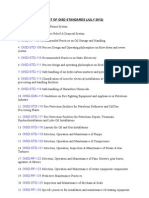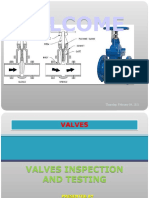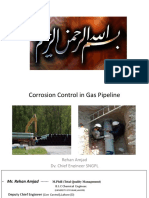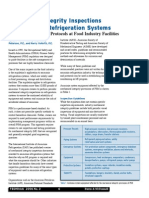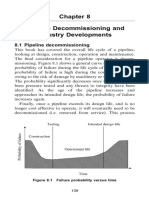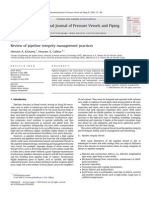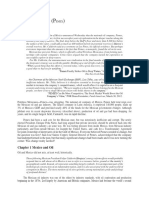100%(1)100% found this document useful (1 vote)
1K viewsOisd 141
Oisd 141
Uploaded by
Jayant MukherjeeThe document provides guidelines for assessing the integrity of cross-country pipelines. It discusses the Oil Industry Safety Directorate (OISD) which regulates safety in India's oil and gas industry. The guidelines cover assessing threats like corrosion, conducting integrity surveys using pigs and tools, evaluating defects, and providing a matrix for integrity assessment of piggable and non-piggable pipelines. The objective is to assess pipeline health over the lifecycle and decide on residual life to safely operate beyond design life.
Copyright:
© All Rights Reserved
Available Formats
Download as PPTX, PDF, TXT or read online from Scribd
Oisd 141
Oisd 141
Uploaded by
Jayant Mukherjee100%(1)100% found this document useful (1 vote)
1K views51 pagesThe document provides guidelines for assessing the integrity of cross-country pipelines. It discusses the Oil Industry Safety Directorate (OISD) which regulates safety in India's oil and gas industry. The guidelines cover assessing threats like corrosion, conducting integrity surveys using pigs and tools, evaluating defects, and providing a matrix for integrity assessment of piggable and non-piggable pipelines. The objective is to assess pipeline health over the lifecycle and decide on residual life to safely operate beyond design life.
Original Description:
Presentation of Oil Industry Safety Directorate 141
Original Title
OISD 141
Copyright
© © All Rights Reserved
Available Formats
PPTX, PDF, TXT or read online from Scribd
Share this document
Did you find this document useful?
Is this content inappropriate?
The document provides guidelines for assessing the integrity of cross-country pipelines. It discusses the Oil Industry Safety Directorate (OISD) which regulates safety in India's oil and gas industry. The guidelines cover assessing threats like corrosion, conducting integrity surveys using pigs and tools, evaluating defects, and providing a matrix for integrity assessment of piggable and non-piggable pipelines. The objective is to assess pipeline health over the lifecycle and decide on residual life to safely operate beyond design life.
Copyright:
© All Rights Reserved
Available Formats
Download as PPTX, PDF, TXT or read online from Scribd
Download as pptx, pdf, or txt
100%(1)100% found this document useful (1 vote)
1K views51 pagesOisd 141
Oisd 141
Uploaded by
Jayant MukherjeeThe document provides guidelines for assessing the integrity of cross-country pipelines. It discusses the Oil Industry Safety Directorate (OISD) which regulates safety in India's oil and gas industry. The guidelines cover assessing threats like corrosion, conducting integrity surveys using pigs and tools, evaluating defects, and providing a matrix for integrity assessment of piggable and non-piggable pipelines. The objective is to assess pipeline health over the lifecycle and decide on residual life to safely operate beyond design life.
Copyright:
© All Rights Reserved
Available Formats
Download as PPTX, PDF, TXT or read online from Scribd
Download as pptx, pdf, or txt
You are on page 1of 51
OIL INDUSTRY SAFETY
DIRECTORATE
OISD- 141 Guidelines for Integrity
Assessment of Cross
Country Pipelines
UNIVERSITY OF
PETROLEUM & ENERGY
STUDIES
By: Jayant Mukherjee
Batch: M Tech HSE 2016-
18
500055653
Content
1. OISD Overview
2. Purpose
3. Scope
4. Definition
5. Reference Documents
6. General
7. Integrity Threat Classification
8. Types of Damages
9. Types of Defects Detected
10.Assessing Defects and Damage in an Ageing
Pipeline System
11.Integrity Assessment of Piggable & Non-
Piggable Pipelines
OISD Overview
Oil & Gas industry in our country is involved in activities
ranging from crude oil exploration, production, refining,
transportation up to distribution of petroleum products to
the end consumer.
At present, all these activities are mostly being carried out
by various Public Sector Oil companies under overall
administrative control of the Ministry of Petroleum and
Natural Gas, Govt. of India.
Ministry of Petroleum and Natural Gas, Govt. of India in
1986, constituted Safety Council assisted by Oil Industry
Safety Directorate (OISD).
Oil Industry Safety Directorate (OISD) is a self-regulatory
body staffed with personnel drawn from various oil
companies.
Major functions of OISD
Oversee the implementation of all the decisions of the
Safety Council
Keep abreast of the latest design and operating
practices in the area of safety and fire fighting in the
hydrocarbon industry
Preparation of Standards
Carryout periodic safety audits, review, suggest
procedures for improvements and report on the
implementation of the suggestions to Safety Council
Collect relevant information and exchange it with the
members of the Oil Industry including information
regarding near miss accidents, accidents and
disasters occurring in the Oil Industry
Ensure implementation of all approved codes of
practices for industrial hygiene
Review disaster control procedures and company
preparedness
Review in-plant training programmes with regard to
safety
SOP FOR INTEGRITY ASSESSMENT OF PETROLEUM
& NATURAL GAS PIPELINES
Purpose
The purpose of the procedure is to assess health and
integrity of old operative & ageing pipelines (beyond
design life), residual life assessment and jobs to be
undertaken by operators for repair of damages/
defects with the objective to prevent incident and
sustain pipeline operation.
Scope
This procedure/ guideline is applicable to cross
country pipelines transporting crude/ petroleum
products /Natural Gas /LPG.
Definitions
Cross country Pipeline: Cross country pipeline means
all pipelines located beyond the boundary of any facility
including pipelines after separator (exploratory well)
and its associated facilities, which are required for
transportation of liquid hydrocarbon from one point to
another excluding piping within the Refinery/ Separation
and / or Processing plant up to plant isolation valves.
Coating: A material applied to a pipeline / structure to
separate it from the environment for preventing
corrosion.
CP: Cathodic Protection A technique to control the
corrosion of a metal surface by making that surface the
cathode of an electrochemical cell. CIPL: Close Interval
Potential Logging is technique for finding coating
defect. Consequence: Means impact on the public,
employees, property and environment due to pipeline
failure.
Design Pressure: The maximum internal pressure
which the pipeline can be subjected to as determined
by design procedure applicable to materials and
locations involved.
DCVG: Direct Current Voltage Gradient is technique
for coating survey.
Earthing: Earthing is provision of a safe path of
electrical current to ground in order to protect
structures, plant and equipment from the effects of
stray electrical current and electrostatic discharges.
Electrical Resistance (ER) /Electrochemical Noise
Technique (ECN)/Linear Polarization Technique
(LPR) probes measure corrosion rates.
IPS: Intelligent Pigging Survey is pipeline inspection
tool.
LSAW : LSAW steel pipe is the abbreviation of
Longitudinally Submerged Arc Welding steel pipe
MPY : Mils penetration per year (MPY) is a unit of
measurement equal to one thousandth of an inch. It is
used to gauge a coupons corrosion rate.
Maximum Allowable Operating Pressure (MAOP):
The maximum pressure at which the pipeline is allowed
to operate. MAOP may be less than or equal to the
design pressure.
Maximum Operating Pressure (MOP): The highest
pressure at which the pipeline is operated during a
normal operating cycle corresponding to a declared
pipeline capacity.
Operating Pressure: It is the pressure corresponding
to a particular flow rate at which pipeline is operated.
Operating pressure may be less than or equal to MAOP.
Operating Company: Shall mean individual,
partnership, corporation or public agency/organization or
any other entity that operates cross country pipeline.
QRA: QRA is abbreviation of Quality Risk Assessment.
Right-ofUser (RoU) / Right-of-Way (RoW): Through
PMP Act1962 or in accordance with the agreement with
the land owner or agency to lay and operate the cross
country liquid hydrocarbon pipeline.
Specified Minimum Yield Strength (SMYS): It is the
minimum yield strength specified by specification or
standard under which material is purchased from the
manufacturer.
Sectionalizing Valve ( SV): Valve (MOVs / HOVs) used
in the cross country pipeline system for isolation of a
SCADA: Acronym for supervisory control and data
acquisition, a computer system for gathering and
analyzing real time data.
Terminal Station / Receiving Station / Receipt
Terminal: Terminal / Receiving station / Receipt
terminal is the last station on the pipeline used for
receipt of liquid hydrocarbon
UT: Ultrasonic Thickness Meter is commonly used for
pipe thickness.
Reference documents
OISD standards 141, 214 and 226
API RP 1160 (Managing System Integrity for
Hazardous Liquid Pipelines)
ASME B31.4 (Pipeline Transportation Systems for
Liquids and Slurries)
ASME B31.8 (Gas Transmission and Distribution Piping
Systems)
ASME B31.8S (Managing System Integrity of Gas
Pipelines)
ASME 31G (Manual for determining the Remaining
Strength of Corroded Pipelines)
General
An Operator with an ageing asset shall determine
extended life beyond initial design limits and ensure
future integrity. In this regard operators must first of
all conduct baseline survey against which the
performance of the pipeline can be judged. This
includes a smart pig run, a review of operating
records, etc. It has to be understood that an accurate
assessment depends on good quality data collected
over the life of the pipeline.
Integrity Threat Classification
Following are the critical monitoring/inspection,
which are essential to assess the health and the
integrity of old and ageing the pipelines:
a) External corrosion
b) Internal corrosion
c) Stress corrosion cracking
TYPES OF DAMAGING AGENTS
Third-Party Damage
Corrosion Related
Equipment
Incorrect Operation
Weather Related
Manufacture
Construction
Environment
Types of defects detected:-
1. External Metal Loss & Internal Metal Loss
2. Leaks, Cracks (including stress corrosion cracking),
Arc Burns
3. Girth Weld Flaws
4. Pipeline manufacturing defects such as pipe weld
defects, ovelity, laminations etc.
5. Dents o Dents with Stress Concentrators o Plain
Dents o Double Dents o Dents that Affect Welds
6. Gouges
7. Wrinkle Bends / Buckles
8. Previous Repairs
9. Mill-Related Anomalies
Assessing Defects and Damage In
An Ageing Pipeline System
Any reported defects in the pipeline can be
assessed using fitness-for-purpose methods. The
analysis and any resulting repair depend upon: i.
defect severity: location, depth, length, orientation, ii.
financial/strategic value of pipeline, iii. threat to
environment & public relations, iv.
regulatory/legal/insurance considerations, v. failure
consequences.
Matrix For Integrity
Assessment Of Piggable And
Non-Piggable Petroleum &
Natural Gas Pipelines
The matrix for integrity assessment of petroleum
and natural gas pipeline has been prepared with the
objective of assessing the health of the pipeline
during its life cycle as well as assessment of residual
life prior to deciding to continue beyond the design
life. This will give a guideline to the industry to
incorporate in their respective SOPs with the ultimate
objective of minimizing failures and sustain pipeline
operations.
PART-I
INTEGRITY ASSESSMENT OF
PIGGABLE PETROLEUM & NATURAL
GAS PIPELINES
1. FEED QUALITY ANALYSIS
It is done with respect to CO2, H2S, Cl, S, moisture
or water, condensate, pH value etc. which is the
type of test. There are three stages which shows
the different hazards.
COMMISSIONING STAGE
To be analysed prior to design. Any deviation w.r.t.
design should be analysed and corrective action
taken w.r.t
(i) source control
(ii) corrosion inhibitor dosing
(iii) odourant dosing
(iv) Pipe metallurgy
DURING DESIGN LIFE SPAN
To be analysed once in a year. Any deviation w.r.t.
design or change in service should be analysed
by management to take corrective action(s) like :
i) design review,
(ii) additional protection for internal corrosion
substantiated by IPS results or
(iii) Change in pipe metallurgy.
BEYOND DESIGN LIFE
To be analysed once in a year.
(i) Past and recent data shall be used for detail
analysis as well deciding pipeline condition for
future use.
2. GEOMETRIC PIGGING
COMMISSIONING STAGE
Geometric pigging should be carried out (prior to
hydro testing) after cleaning of
pipeline using foam pig and cleaning pig, to
identify ID, dents, pipeline bend condition etc., in
the entire pipeline etc.,
Deviations should be corrected prior to
commissioning
If the pipeline commissioning after pressure
testing is anticipated to be delayed beyond six (6)
months, pipeline shall be preserved using
corrosion inhibitors or by filling the line with non-
flammable non-toxic gas and at a positive pressure
3. SCRAPPER PIGGING
DURING DESIGN LIFE SPAN
The foam pig should not be used in place of
scrapper pig. The frequency of cleaning will be as
per OISD-STD-141, 226 and 214 as under:
(i) Non ATF Petroleum Product Pipelines - once in
six months.
(ii) ATF pipelines also carrying other petroleum
products once in three months.
(iii) Dedicated ATF Pipelines once in a year.
(iv) Crude Oil Pipelines once in three months.
BEYOND DESIGN STAGE
The foam pig should not be used in place of
scrapper pig. The frequency of cleaning will be as
per OISD-STD-141, 226 and 214 as under:
(i) Non ATF Petroleum Product Pipelines - Once in
six months.
(ii) ATF pipelines also carrying other petroleum
products - once in three months.
(iii) Dedicated ATF Pipelines once in a year.
(iv) Crude Oil Pipelines once in three months.
(v) Two phase / multiphase flow once in a year
(or more frequently if there is
significant liquid hold-up)
4. PIG RESIDUE ANALYSIS
DURING DESIGN LIFE SPAN AND BEYOND
The quantity of muck and residue analysis of each
pigging should be compared and a trend should
be analysed w.r.t. the tendency of corrosion /
deterioration of pipeline. If there is an increase in
quantity of muck /corrosion product, other
corrosive indications, such as sulphur, pH, H2S etc.
the pigging frequency should be increased and
corrosion rate should be determined. Increased
trend in corrosion product is the signal that feed
quality to be analysed immediately to ascertain
the corrosivity.
5. INTERNAL CORROSION
MONITORING
BEYOND AND DURING DESIGN LIFE SPAN
Corrosion monitoring facilities (corrosion coupons
and ER probes), electrochemical noise technique
(ECN probes) or Linear polarization technique (LPR
probes), UT sensors etc., shall be installed in liquid
/ Natural Gas/LPG pipelines in line with OISD-
STD-141/OISD-STD-226/OISD-STD-214. For wet
natural gas line also the corrosion coupon &
probes at appropriate locations shall be provided
for assessing internal corrosion rate.
If the rate of corrosion is more than 1 MPY, suitable
doses of corrosion
inhibitor shall be injected to mitigate the internal
corrosion and a corrosion rate monitoring program
should be implemented
The wet natural gas should be considered
corrosive and inhibitor dosing is must
since beginning along with monitoring of
effectiveness of corrosion inhibitor.
Internal corrosion data should be cross verified
with IP results and fitness assessment details to
decide for pipe repair / replacement.
6. INTELLIGENT PIGGING
SURVEY
COMMISSIONING STAGE, DESIGN LIFE AND
BEYOND LIFE SPAN
In this IPS the internal inspection tools shall be
capable of detecting corrosion, stress corrosion
cracking (only for oil pipelines), illegal fittings
intending for pilferage and deformation anomalies
including dents, gouges, grooves, previous
repairs , Mill-Related Anomalies and weld cracks.
.
The decision of using weld crack detection tools
shall lie on the individual pipeline operator based
on the condition of seam weld and girth weld and
on the basis of the last IPS carried out as stated
7. Cathodic protection,
monitoring, upgrading and
effectiveness testing.
COMMISSIONING STAGE
In case, permanent Cathodic Protection is not
available within six (6) months from the start of
pipeline laying, sacrificial anode based Temporary
CP to be ensured. This should be made permanent
within six months.
Permanent CP system design to ensure
continuous power availability through battery
backup at designated locations along ROW.
DURING LIFE STAGE
SP readings at feeding points shall be monitored
fortnightly.
The PSP reading (ON potential) at the TLPs for
entire pipeline to be taken once in a quarter and
survey results shall be plotted graphically to
identify and locate cathodic holidays/ un-protected
strech of pipeline.
Instant PSP off potential along with ON PSP
readings at test lead points of entire pipeline shall
be taken once in a year.
8. COATING SURVEY
DURING DESIGN LIFE SPAN
Once in 5 years.
As per the identification of damage of the
coating, repair should be taken up
Immediately.
BEYOND THE LIFE SPAN
Coating Survey :
Within one year immediately after completion of
design life, Pearson/ CAT/DCVG Survey to be
carried out for the entire pipeline.
9. SOIL TESTING
DURING DESIGN LIFE SPAN
If any industrial effluent is flowing over the
ROW/ROU or any environmental change is noticed
on the ROW, or there is any significant increase in
current density, the soil samples shall be tested
for determining the efficacy of the existing
coating and wrapping of the pipeline. During
patrolling the line walker to take note of the any
environmental changes or any industrial effluent
entering the ROW.
Based on this report, soil investigation needs to
be planned.
Soil resistivity test shall be carried out once in
ten years in line with clause no.
BEYOND THE LIFE SPAN
Within one year immediately after completion of
design life, Soil resistivity survey shall be carried
out.
After that, Soil resistivity test shall be carried out
once in ten years in line with clause no. 5.15 of
OISD-STD-188.
10. REGULAR LINE
PATROLLING
Each operating company shall maintain a periodic
pipelines patrol program.
Road and railway crossings shall be inspected at
least once in 3 months.
Water body crossings shall be inspected at least
twice a year i.e. prior to and after monsoon or
flash flood for exposure.
Line Walk by company official at least once in a
year for entire length of pipeline shall be carried
out after the monsoon.
LIQUID PIPELINES
Rail/Road Bridge, Suspended crossings shall be
inspected once in 3 months to check
supports/structures and anti-corrosion coatings
where pipe exits/enters ground.
Ground / Aerial Patrolling of ROW - twice in a
week (urban areas and non-urban areas) to
observe surface conditions, leakage, any
construction activity, encroachments, washouts
and any other factors affecting the safety and
operation of pipeline.
GAS PIPELINES
Patrolling of ROU/ROW shall be carried out once
in 30 days for location class 3 and 4 and once in
90 days (once in a quarter) for location class 1 and
11. Inspection of leak
detection system
DURING DESIGN LIFE STAGE
Proper functioning of leak detection system shall
be re-checked.
Effectiveness of the operation to be checked
once in a year
BEYOND THE LIFE SPAN
History of leak data and nos. with type of repair
shall be used for upgrading
/replacement of leak detection system.
12. Inspection of
communication and control
system
DURING DESIGN LIFE SPAN AND BEYOND
Installation of dedicated communication system,
control system, safety interlock and SCADA to be
ensured.
Proper functioning of communication system,
control system and safety interlocks shall be re-
checked and ensured need to be upgraded, if
functionality is found poor.
Base data and nos. with type of repair shall be
used for replacement / upgradation of
Part II
MATRIX FOR INTEGRITY ASSESSMENT OF NON-
PIGGABLE PETROLEUM & NATURAL GAS
PIPELINES
1. Feed Quality Analysis
It is done with respect to CO2, H2S, Cl, S, moisture
or water, condensate, pH value etc. which is the
type of test. There are three stages which shows
the different hazards.
New pipeline/ Construction & commissioning
Stage
To be analysed prior to design. Any deviation w.r.t.
design should be analysed and corrective action
taken w.r.t
(i) source control
(ii) corrosion inhibitor dosing
During design life span
To be analysed once in a year. Any deviation w.r.t.
design or change in service should be analysed by
management to take corrective action(s) like :
(i) design review
(ii)additional protection for internal corrosion
substantiated by IPS results, if possible or
(iii)Change in pipe metallurgy
Beyond design life
To be analysed once in a year, Past and recent
data shall be used for detail analysis as well
deciding pipeline condition for future use.
2. Internal Corrosion
Monitoring
New pipeline/ Construction & commissioning
Stage
Provision for installation of probe/coupon should be
ensured at initial stage.
During design life span
If the rate of corrosion is more than 1 MPY,
suitable doses of corrosion inhibitor shall be
injected and a corrosion rate monitoring program
should be implemented.
The wet natural gas should be considered
corrosive and inhibitor dosing is must since
beginning along with monitoring of effectiveness of
corrosion inhibitor.
Beyond design life
If the rate of corrosion is more than 1 MPY,
suitable doses of corrosion inhibitor shall be
injected and a corrosion rate monitoring program
should be implemented. The wet natural gas
should be considered corrosive and inhibitor
dosing should continue since beginning along with
monitoring of effectiveness of corrosion inhibitor
Internal corrosion data shall be cross verified
with IP results and fitness assessment details to
decide for pipe repair / replacement.
3. Internal Corrosion Direct
Assessment (ICDA)
To be carried out in line with OISD-GDN-233, NACE
SP-0206- 2006, NACE SP-0208-2008,NACE SP-0110
2010
New pipeline/ Construction & commissioning
Stage
Internal Corrosion Direct Assessment to be done
not later than 10 years of commissioning intending
to create base line data.
Defects detected with ICDA to be corrected.
During design life span
Frequency of Internal corrosion direct
assessment shall, in no case, be more than 10
years. In place of ICDA, if possible, IPS tool for non-
piggable pipeline, which gives complete wall
thickness measurements, can be used and internal
corrosion phenomenon/ rate can be measured.
Defects detected with ICDA to be corrected
within recommended time.
Beyond design life
Within one year immediately after completion of
design life, ICDA shall be carried out &
subsequently frequency shall be decided based on
the findings and not later than 8 years interval.
4. Cathodic protection,
monitoring, upgrading and
effectiveness testing.
New pipeline/ Construction & commissioning
Stage
In case, permanent Cathodic
During design life span Protection is not
available within 6 months from the start of
pipeline laying, sacrificial anode based Temporary
CP to be ensured. This should be made permanent
within six months.
Permanent CP system design to ensure
continuous power availability thru battery backup
at designated locations along ROW.
During design life span
PSP readings at feeding points shall be
monitored fortnightly. The PSP reading (ON
potential) at the TLPs for entire pipeline to be
taken once in a quarter and survey results shall be
plotted graphically to identify and locate cathodic
holidays.
Instant PSP off potential readings at test lead
points of entire pipeline shall be taken once in a
year.
Beyond design life
Current consumption data/ current density data/
protection level of the line etc., to be analysed for
each pipeline (half yearly.
5. Coating survey (CAT/
DCVG/ CIPS)
New pipeline/ Construction & commissioning
Stage
One month after Commissioning of permanent CP
in the pipeline.
During design life span
Once in 5 years. As per the identification of
damage of the coating repair should be taken up
immediately
Beyond design life
Based on overall analysis, if required large scale
coating reconditioning program or upgradation of
CP unit should be planned.
Within one year immediately after completion of
design life, External Corrosion Direct Assessment
(ECDA) shall be carried out on the basis of the
results of CAT/ DCVG/ CIPL survey and as per NACE
SP-0502-2010
6. Soil Testing
During design life span
If any industrial effluent is flowing over the
ROW/ROU or any environmental change is noticed
on the ROW, or there is any significant increase in
current density, the soil samples shall be tested
for determining the efficacy of the existing coating
and wrapping of the pipeline.
During patrolling the line walker to take note of
the any environmental change or any industrial
effluent entering the ROW.
Soil resistivity test shall be carried out once in
ten years in line with clause no. 5.15 of OISD-STD-
188.
Beyond design life
Within one year immediately after completion of
design life, Soil resistivity survey shall be carried
out.
After that Soil resistivity test shall be carried out
once in ten years in line with clause no. 5.15 of
OISD-STD-188.
Previous data shall be used for risk analysis etc.
7.Risk assessment
New pipeline/ Construction & commissioning
Stage
Quantitative Risk Assessment to be carried out at
the design stage with special focus on high
consequence area and risk should be identified
with fatality frequency curve. Measures should be
taken to bring down the risk to acceptable level.
During design life span
Quantitative Risk Assessment (QRA) to be
carried out once in 5 years to identify the risk
considering the actual population and effect
at high risk area or low risk area has become
high risk area due to increase in population
and permanent settlements. The risk
reduction measures should be implemented.
Beyond design life
Risk assessment shall be carried out after
completion of design life as per ASME B31.4 &
ASME B31.8, ASME B31.8S, API 1160, ASME
31G.
You might also like
- Oisd STD 244 PDFDocument125 pagesOisd STD 244 PDFoperating pandaNo ratings yet
- API2611 ArticleDocument4 pagesAPI2611 ArticlepemyconsultingNo ratings yet
- Oil Oisd STD 188Document39 pagesOil Oisd STD 188sekharsappa2100% (1)
- Oisd STD-141Document31 pagesOisd STD-141Jyotsana Rawat83% (6)
- Oisd 117Document63 pagesOisd 117Gagandeep SinghNo ratings yet
- OISD 119 Pump MaintenanceDocument18 pagesOISD 119 Pump MaintenanceSanath Kumar100% (2)
- Valve Leakage Rates Test STDDocument5 pagesValve Leakage Rates Test STD윤병택No ratings yet
- MB Lal CommitteeDocument23 pagesMB Lal CommitteechemsaneNo ratings yet
- Pipeline Defect Assessment ManualDocument18 pagesPipeline Defect Assessment Manualhadi13775% (4)
- Pipeline Defect Assessment ManualDocument18 pagesPipeline Defect Assessment Manualalexrodriguezabc100% (6)
- Oisd 226 For Pipeline IntegrityDocument21 pagesOisd 226 For Pipeline IntegrityAmritesh Pandey100% (3)
- Pipeline Maintenance Inspection & RepairDocument49 pagesPipeline Maintenance Inspection & RepairIrsyad Rosyidi100% (1)
- Inspection OF Pipes, Valves and Fittings: OISD - 130Document28 pagesInspection OF Pipes, Valves and Fittings: OISD - 130Jesse Garcia OlmosNo ratings yet
- Pipe LineDocument62 pagesPipe LineBahtiar Anak LaNang100% (1)
- OISD STD 138 Safety Cross Country Pipeline OnshoreDocument14 pagesOISD STD 138 Safety Cross Country Pipeline OnshoreNarendrasinhNo ratings yet
- Peso Interview QuestiionsDocument3 pagesPeso Interview QuestiionsrajeshNo ratings yet
- Oisd STD-214Document45 pagesOisd STD-214grabsp100% (4)
- Oisd STD 153Document34 pagesOisd STD 153Anonymous i3lI9M100% (3)
- Rim SealDocument6 pagesRim SealVasant Kumar VarmaNo ratings yet
- Oisd STD 139 (Old)Document10 pagesOisd STD 139 (Old)Ravikumar mahadevNo ratings yet
- Pipeline RepairsDocument18 pagesPipeline RepairsN P SrinivasaraoNo ratings yet
- OISD StandardsDocument12 pagesOISD StandardsPratiek RaulNo ratings yet
- IS 15394.2003 Fire Safety in Petroleum RefineriesDocument16 pagesIS 15394.2003 Fire Safety in Petroleum RefineriesnpwalNo ratings yet
- OISDDocument96 pagesOISDsr_rao99100% (1)
- Rim Seal Fire Protection SystemDocument21 pagesRim Seal Fire Protection SystemSuraj singhNo ratings yet
- Oisd - 128 PDFDocument34 pagesOisd - 128 PDFmotasem100% (2)
- Oisd STD 121Document25 pagesOisd STD 121Nanu PatelNo ratings yet
- STD 130Document55 pagesSTD 130raj1508No ratings yet
- List of Oisd StandardsDocument6 pagesList of Oisd StandardsManish Kumar100% (3)
- Oisd RP 124Document18 pagesOisd RP 124ajay100% (1)
- Corrosion in PipelineDocument56 pagesCorrosion in PipelineMikiRoniWijayaNo ratings yet
- Oisd STD 133Document60 pagesOisd STD 133ck19654840100% (1)
- Oisd 141 PDFDocument31 pagesOisd 141 PDFajayNo ratings yet
- Oisd STD 226-2013 Y06y2908Document93 pagesOisd STD 226-2013 Y06y2908saurabh100% (1)
- Operation and Maintenance Guidelines For PL and Compressor Booster StationsDocument83 pagesOperation and Maintenance Guidelines For PL and Compressor Booster StationsUmer Khan100% (1)
- STD 128 PDFDocument47 pagesSTD 128 PDFsanchitaNo ratings yet
- MM MM - 15 15 - 015: 015: MM MM - 15 15 - 015: 015:: Heat Treatment Heat Treatment Heat Treatment Heat TreatmentDocument395 pagesMM MM - 15 15 - 015: 015: MM MM - 15 15 - 015: 015:: Heat Treatment Heat Treatment Heat Treatment Heat TreatmentShuvoVattNo ratings yet
- Oisd RP 167Document28 pagesOisd RP 167akhilendraa6221100% (5)
- Refinery InspectionDocument44 pagesRefinery Inspectiongamadiya100% (1)
- Furnace Tube Pipeline PiggingDocument8 pagesFurnace Tube Pipeline PiggingPervez0% (1)
- Oisd STD 141Document73 pagesOisd STD 141SRNo ratings yet
- Oisd STD 163Document20 pagesOisd STD 163Shah IrfanNo ratings yet
- Oisd GDN 232Document69 pagesOisd GDN 232Nilesh JogalNo ratings yet
- Oisd 134Document37 pagesOisd 134skgbondNo ratings yet
- Valves and Valves Inspection & TestingDocument36 pagesValves and Valves Inspection & TestingSathish P Sathish Palanichamy100% (1)
- Oisd Sop PipelineDocument21 pagesOisd Sop PipelineChirag Patel100% (1)
- Pipeline Integrity Management ExternalDocument36 pagesPipeline Integrity Management ExternalJavierfox98100% (7)
- Emmanuel 2014Document7 pagesEmmanuel 2014Hà Thị TrúcNo ratings yet
- Best Practice On Defect Assessment - ECA AnalysisDocument12 pagesBest Practice On Defect Assessment - ECA Analysisarchitectintx100% (2)
- 0900 Corrosion Control in Gas PipelineDocument58 pages0900 Corrosion Control in Gas PipelineAbdul Maabood Hassan AlviNo ratings yet
- Mechanical Integrity Inspections For Ammonia Refrigeration SystemsDocument3 pagesMechanical Integrity Inspections For Ammonia Refrigeration Systemsعزت عبد المنعمNo ratings yet
- Alkazri - 2008 - A Quick Guide To Pipeline Engineering - 4 Pipeline Decommissioning and Industry DevelopmentsDocument9 pagesAlkazri - 2008 - A Quick Guide To Pipeline Engineering - 4 Pipeline Decommissioning and Industry DevelopmentsRUSSEL SAHDA MALAKANo ratings yet
- Extend Life Aging PipelinesDocument20 pagesExtend Life Aging PipelinesPar MadNo ratings yet
- Case Study On Corrosion Assessment of Infield Pipelines byDocument10 pagesCase Study On Corrosion Assessment of Infield Pipelines byHazim NaharNo ratings yet
- Flowlines and Well Gas Lift LinesDocument4 pagesFlowlines and Well Gas Lift LinesDaniel Dambo100% (2)
- Remining Life AssessmentDocument11 pagesRemining Life AssessmentJuliyan Pujakesuma100% (2)
- Pipeline and Riser System Design Course ManualDocument146 pagesPipeline and Riser System Design Course Manualdiepriye100% (7)
- Review of Pipeline Integrity ManagementDocument8 pagesReview of Pipeline Integrity ManagementTaib Anwar100% (2)
- Pipeline and Piping IntegrityDocument10 pagesPipeline and Piping IntegrityAmitkumar GhadgeNo ratings yet
- Sui Northern Gas Pipelines LimitedDocument26 pagesSui Northern Gas Pipelines LimitedHaider AliNo ratings yet
- An Intelligent Pigging Project: Start To Finish: by William R Gwartney, JR, and Ed SchaeferDocument8 pagesAn Intelligent Pigging Project: Start To Finish: by William R Gwartney, JR, and Ed SchaeferscrbdgharaviNo ratings yet
- Ie RulesDocument36 pagesIe RulesJayant MukherjeeNo ratings yet
- SWP 68 Journey ManagementDocument4 pagesSWP 68 Journey ManagementJayant MukherjeeNo ratings yet
- Ammonia PPT by Jayant FinalDocument19 pagesAmmonia PPT by Jayant FinalJayant Mukherjee100% (2)
- Dispersible Tablets: BY: Ankita AwasthiDocument30 pagesDispersible Tablets: BY: Ankita AwasthiJayant MukherjeeNo ratings yet
- Efficient Steam Generation & DistributionDocument64 pagesEfficient Steam Generation & DistributionMukesh Jha15021983100% (4)
- BiomassDocument28 pagesBiomassSameer DNo ratings yet
- Sop Kfupm ProductionDocument2 pagesSop Kfupm ProductionMuhammad AliNo ratings yet
- Synopsis Format-Practice SchoolDocument4 pagesSynopsis Format-Practice SchoolArjun GoyalNo ratings yet
- Chapter 1Document70 pagesChapter 1RahulKrishnanNo ratings yet
- White Paper On Impact of Free Trade Agreements On Indian Petrochemical IndustryDocument72 pagesWhite Paper On Impact of Free Trade Agreements On Indian Petrochemical IndustryGhanshyamNo ratings yet
- McEntegart ResumeDocument3 pagesMcEntegart ResumeaaaNo ratings yet
- Petroleum of IraqDocument20 pagesPetroleum of IraqOswa LrNo ratings yet
- Refinery Process DescriptionDocument24 pagesRefinery Process DescriptionjeyalaksNo ratings yet
- Naphtha Production: Department of Chemical Engineering NIT CalicutDocument9 pagesNaphtha Production: Department of Chemical Engineering NIT CalicutAhmed Khamees Shatla100% (1)
- National Energy Balance 2021Document90 pagesNational Energy Balance 2021rp327No ratings yet
- Fire Protection Facilities FOR Petroleum Depots, Terminals, Pipeline Installations AND Lube Oil InstallationsDocument42 pagesFire Protection Facilities FOR Petroleum Depots, Terminals, Pipeline Installations AND Lube Oil InstallationsSanjay PatelNo ratings yet
- Bagajewicz2001 PDFDocument10 pagesBagajewicz2001 PDFamitNo ratings yet
- PTQ - Corrosion and Fouling Challanges and Solution PDFDocument10 pagesPTQ - Corrosion and Fouling Challanges and Solution PDFPhatchara Chuaykerd100% (1)
- Petroject Corporate FilesDocument33 pagesPetroject Corporate FilesRRHH0% (1)
- rr1113 HSE Vapour Cloude Explosion PDFDocument326 pagesrr1113 HSE Vapour Cloude Explosion PDFRoger BoursNo ratings yet
- VivaDocument13 pagesVivapapia_das876156No ratings yet
- Caso PEMEXDocument10 pagesCaso PEMEXemilioarredondoariasNo ratings yet
- 2015 Oil Gas RefiningDocument33 pages2015 Oil Gas RefininggustavoemirNo ratings yet
- Literature Review On Fractional Distillation of Crude OilDocument4 pagesLiterature Review On Fractional Distillation of Crude Oilc5qxzdj7No ratings yet
- Refining of PetroleumDocument4 pagesRefining of PetroleumVasant Kumar VarmaNo ratings yet
- Uk Trouvaycauvin FVDocument16 pagesUk Trouvaycauvin FVNassim Ben AbdeddayemNo ratings yet
- InventoryDocument5 pagesInventorytickoo10% (2)
- Whole Unit 2 - Crude Oil and Refining Product TestingDocument113 pagesWhole Unit 2 - Crude Oil and Refining Product Testingprathamesh singhNo ratings yet
- Fuels & Fairness Study Guide v1Document32 pagesFuels & Fairness Study Guide v1ChunkyLuverRudyNo ratings yet
- EACOPDocument11 pagesEACOPgodwin.jimmykahuutaNo ratings yet
- 2010-01-Trafotech2010 TRF Oil Specifications For Indian TRF Industry PDFDocument9 pages2010-01-Trafotech2010 TRF Oil Specifications For Indian TRF Industry PDFVishnu ShankerNo ratings yet
- !indx SaerDocument1 page!indx SaerhakashuNo ratings yet
- 3DTCOS Reduces Overhead Corrosion Control CH-1960Document4 pages3DTCOS Reduces Overhead Corrosion Control CH-1960Atul ChoudhariNo ratings yet
- Ot SyllabusDocument28 pagesOt SyllabusMohcyn MunyrNo ratings yet
- PPIC in Petrochemical - Rev.1Document21 pagesPPIC in Petrochemical - Rev.1muhammmad irfanNo ratings yet




























